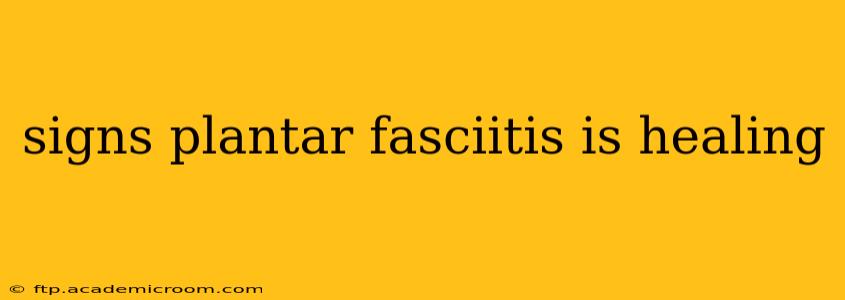Plantar fasciitis, that nagging heel pain that makes even a short walk feel like a marathon, can be incredibly frustrating. But the good news is, it does heal. While recovery time varies, recognizing the signs your plantar fasciitis is improving is crucial for maintaining motivation and ensuring you're on the right track. This guide will delve into the key indicators that your plantar fasciitis is responding to treatment, answering common questions along the way.
How Long Does it Take for Plantar Fasciitis to Heal?
This is a common question, and unfortunately, there's no one-size-fits-all answer. Recovery time depends on several factors, including the severity of the condition, your overall health, adherence to treatment plans, and individual healing rates. While some experience relief within a few weeks, others may require several months or even longer. Patience and consistent treatment are key.
What are the Early Signs of Plantar Fasciitis Healing?
The early stages of healing can be subtle. Don't expect dramatic overnight changes. Instead, look for these gradual improvements:
Reduced Morning Stiffness and Pain
One of the most hallmark symptoms of plantar fasciitis is the intense stiffness and pain felt first thing in the morning. As your plantar fascia heals, you'll notice this morning stiffness lessening. You might still experience some discomfort, but it will be significantly reduced in intensity and duration.
Decreased Pain During and After Activity
Initially, even short walks or standing for prolonged periods could be excruciating. As healing progresses, you should find that pain during and after activity decreases. You may be able to walk or stand for longer periods without experiencing intense pain. This gradual increase in activity tolerance is a positive sign.
Improved Range of Motion in Your Ankle and Foot
Plantar fasciitis can restrict your ankle and foot's range of motion. As your condition heals, you'll notice improved flexibility and ability to move your foot and ankle more freely without discomfort.
Less Pain When Pressing on the Heel
Direct pressure on your heel usually elicits pain in plantar fasciitis. As healing progresses, pressing on your heel should become less painful, eventually returning to normal.
How Do I Know if My Plantar Fasciitis is Getting Worse?
While focusing on positive signs is important, it's equally crucial to be aware of warning signs that indicate your condition is worsening, rather than improving. These include:
- Increased pain intensity: If your heel pain intensifies unexpectedly, it's a red flag.
- Pain spreading to other areas of your foot or leg: Pain radiating up your leg or affecting other parts of your foot warrants immediate medical attention.
- Numbness or tingling in your toes: These symptoms could point to nerve involvement and require evaluation by a healthcare professional.
- Inability to bear weight: If you can no longer put weight on your affected foot, seek immediate medical care.
What if My Plantar Fasciitis Isn't Healing?
If you've been diligently following your treatment plan for several weeks or months and see little to no improvement, it's important to consult your doctor or a podiatrist. They may need to re-evaluate your treatment strategy, order additional tests (like X-rays to rule out other issues), or explore different treatment options. Don't hesitate to seek professional help if your plantar fasciitis isn't showing signs of healing.
Conclusion: Patience and Persistence are Key
Healing from plantar fasciitis takes time and patience. While there's no magic bullet, recognizing the subtle signs of improvement—reduced pain, improved flexibility, and increased activity tolerance—is crucial for maintaining hope and commitment to your treatment plan. Remember that consistency is key; consistently following your prescribed treatment, including stretching, strengthening exercises, and potentially orthotic support, will significantly improve your chances of a full recovery. If you have concerns or experience worsening symptoms, always seek professional medical advice.
